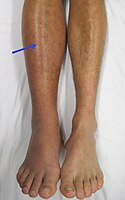
Photo from wikipedia
TOPIC: Chest Infections TYPE: Medical Student/Resident Case Reports INTRODUCTION: Coronavirus disease (COVID-19) is a global health crisis. It is associated with increased activation of the clotting system leading to thrombotic… Click to show full abstract
TOPIC: Chest Infections TYPE: Medical Student/Resident Case Reports INTRODUCTION: Coronavirus disease (COVID-19) is a global health crisis. It is associated with increased activation of the clotting system leading to thrombotic complications in 5 to 23% of cases[1]. It is known to cause significant venous thromboembolism and few cases with arterial thrombosis with increased risk of life-threatening complications like myocardial infarction, ischemic stroke, splenic infarct, and left ventricular clot have been reported[2]. CASE PRESENTATION: A 70-year-old female with a past medical history of coronary artery disease, Hypertension, COPD, recent COVID-19 (3 weeks ago) not requiring admission to hospital presented to the hospital with bilateral leg and forearm pain. Leg pain was worse with activity. She had feeble peripheral pulses on palpation.She underwent Computed Tomography angiography which showed extensive arterial thrombosis involving the distal abdominal aorta, left common iliac artery, superior mesenteric artery, and also showed an area of wedge-shaped infarction in the spleen. She had a thrombus at the apex of the left ventricle, with incidental 1.3 cm spiculated mass in the left lung. There was no evidence of venous thromboembolism in imaging.She was started on therapeutic anticoagulation with heparin. After multidisciplinary discussion with Hematology, Vascular surgery, and Cardiology, her anticoagulation was changed to Enoxaparin. She was managed medically. Workup including JAK2, beta-2 glycoprotein antibodies, lupus anticoagulant, and anticardiolipin antibodies was negative. DISCUSSION: The exact mechanisms that activate coagulation cascade in SARS-CoV-2 infection are still unknown, but they are found to be associated with increased thrombogenesis. SARS-CoV-2 viral infection can activate the plasmatic clotting system by activating multiple procoagulant pathways. Angiotensin-converting enzymes 2 are normally found on various cells such as lymphocytes, alveolar cells, monocytes/macrophages, and platelets. In SARS-CoV-2 infection, Surface S protein of SARS-CoV-2 binds to its target transmembrane receptor( ACE2 protein) and down-regulates the expression of ACE2 protein. It leads to the accumulation of angiotensin II in the body which interacts with platelets and endothelial cells leading to further promotion of clot formation[3]. This was the likely cause of hypercoagulable state in our patient leading to thrombosis. CONCLUSIONS: An extensive arterial clot can be the initial presentation in COVID-19 patients and can be treated promptly with anticoagulation. Early introduction of prophylactic anticoagulation is necessary to prevent clot formation. REFERENCE #1:.Thromboinflammation and the hypercoagulability of COVID-19. Connors JM, Levy JH J Thromb Haemost.2020 Jul;18(7):1559-1561. REFERENCE #2: Coagulation disorders in coronavirus infected patients: COVID-19, SARS-CoV-1, MERS-CoV, and lessonsfrom the past.Giannis D, Ziogas IA, Gianni P J Clin Virol. 2020 Jun;127():104362. REFERENCE #3: Smith S A, Mutch N J, Baskar D, Rohloff P, Docampo R, Morrissey J H. Polyphosphate modulates bloodcoagulation and fibrinolysis. Proc Natl Acad Sci U S A. 2006;103(04):903–908. DISCLOSURES: No relevant relationships by Sumit Gami, source=Web Response No relevant relationships by Subash Ghimire, source=Web Response No relevant relationships by Sushmita Khadka, source=Web Response No relevant relationships by Shobha Mandal, source=Web Response
Journal Title: Chest
Year Published: 2021
Link to full text (if available)
Share on Social Media: Sign Up to like & get
recommendations!